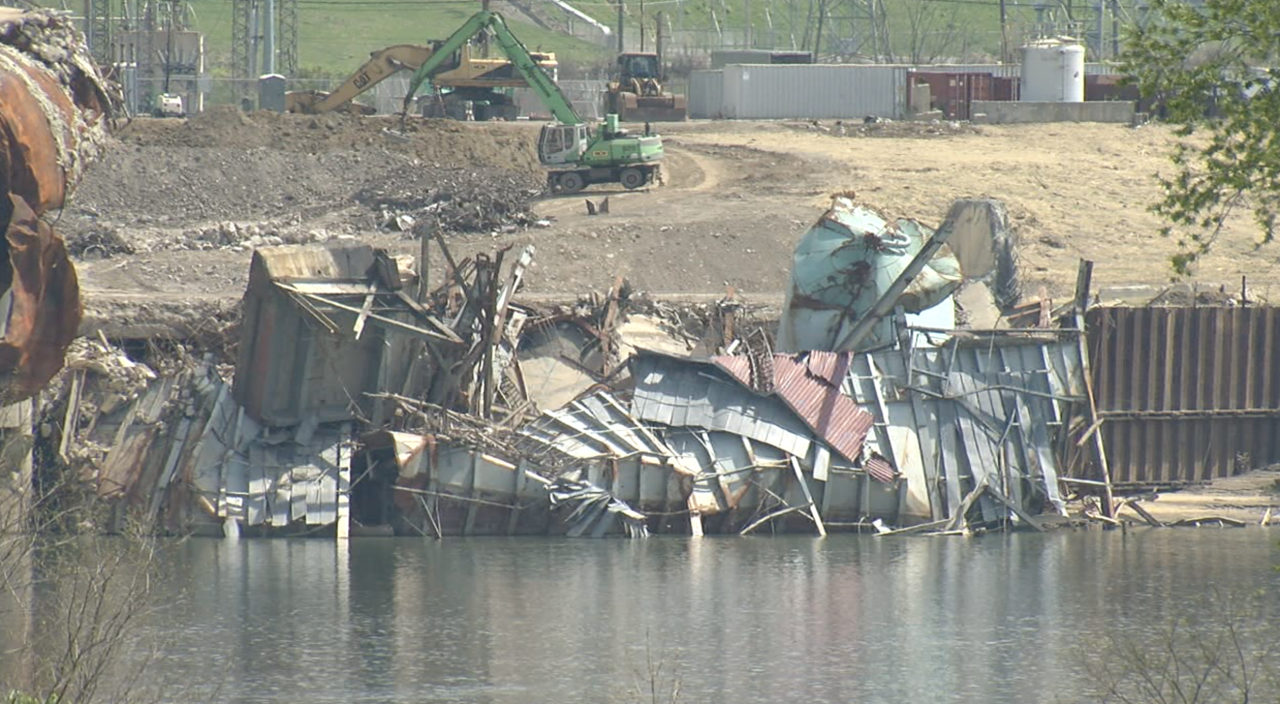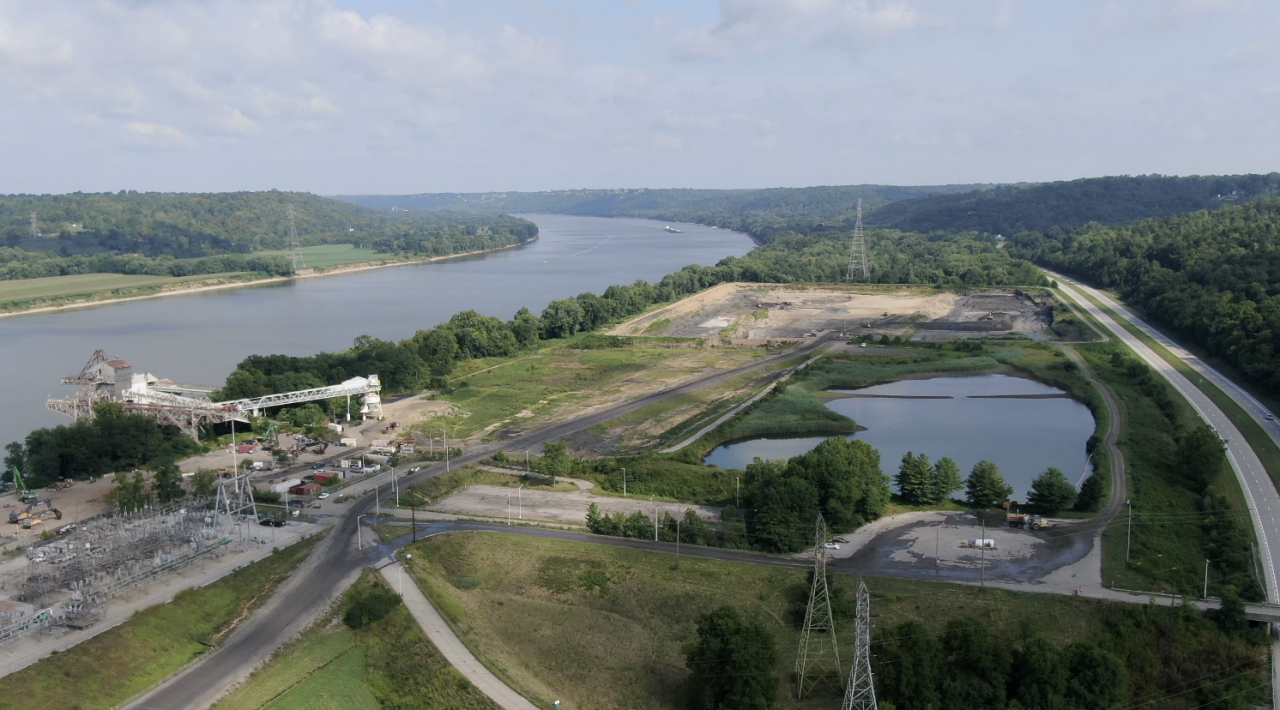NEW RICHMOND, Ohio — More than 100 Clermont County residents are suing the owner of the former Walter C. Beckjord coal plant, claiming that open dumping of coal ash is threatening to cause an environmental catastrophe.
“The biggest thing that affects the general public is to try to get the contamination cleaned up,” said attorney Dave Altman, who represents the nonprofit citizen group, Neighbors Opposed to Pit Expansion, or NOPE, in their lawsuit.
Altman filed the lawsuit against the owner of the former Beckjord site, Missouri-based Commercial Liability Partners and subsidiary New Richmond Development Corp., on Dec. 21 in U.S. District Court in Cincinnati. It asks for damages, civil penalties and an order forcing the company to stop alleged open dumping of toxic coal ash.
Residents and local leaders are very concerned about the six million cubic yards of coal fly ash that are stored in unlined man-made pits, also known as ponds, perched along the Ohio River, which is a source of drinking water for more than 5 million people. The ponds are in the river’s floodplain and directly upgradient from county public drinking water wells which serve 130,000 people.

“The drinking water supply is a great concern,” Altman said. “When there are unlined ponds, and they have nothing to contain what’s in them… the river will go up inside and scour out the contamination and carry it outward back into the river or push it into the groundwater inland.”
A by-product of burning coal, the U.S. EPA states on its website that fly ash contains contaminants such as mercury and arsenic.
Coal ash exposure causes higher risk of cancer in the skin, liver, bladder, and lungs, as well as neurological and psychiatric effects, cardiovascular impacts, damage to blood vessels, and anemia. It also threatens plant and animal wildlife, causing elevated selenium levels in migratory birds, wetland vegetative damage, fish kills, fish and amphibian deformities, and plant toxicity, according to the lawsuit.

This lawsuit may resolve numerous complaints from residents and local officials. In the past two years, the I-Team has reported on blowing clouds of fly ash, ground and drinking water concernsand a smokestack that fell into the Ohio River during demolition.
Neighbors sued CLP for the first time in 2019, claiming it violated a 1986 agreement to inform the public about contaminated waste disposal. Both suits are now pending before U.S. District Court Judge Michael Barrett.

Built in the 1950s as a coal-burning giant, the Beckjord plant pumped electricity to hundreds of thousands of homes and businesses across Southwest Ohio.
Duke Energy closed Beckjord in 2014 and sold the 1400-acre site to CLP four years later. CLP is now demolishing the plant and cleaning up the site, with tentative plans to build a port terminal.
“We remain in full compliance with all regulation at the site. Our policy is not to comment on pending litigation, and we will address the allegations of NOPE's attorneys in the context of the lawsuit,” according to a CLP spokesman.
But the lawsuit claims that no agency is actively regulating coal ash at the Beckjord site.
Ohio is one of only a few states to exempt coal ash as a solid waste. That means the Ohio EPA has no authority to regulate how it is transported or stored in unlined leaking ponds along the Ohio River, according to the lawsuit.
But federal law is enforceable, Altman said.
“It’s time to cure, if we prove our case, the years of lack of regulation,” Altman said. “And to come clean with the public that the Ohio EPA never had the authority to directly regulate this fly ash. Therefore, it wasn’t regulated, and the public didn’t know that.”

Altman wants CLP to remove the coal ash from leaking, unlined pits and move it to a lined sanitary landfill.
CLP’s contractors are relocating coal ash from the oldest unlined pond on site, Pond A, to another unlined pond further south, Pond C, worrying many residents.
“Control them ash pits they got down there. They’ve been moving those ash pits,” said Judy Hurst, who grew up on the floodplain close to Beckjord. She now lives a few miles away in Clermontville.
“Some days down here, when I’ve been here, when you go down (Route) 52 you have to roll your windows up because the smoke, whatever that is, it’s all over,” Hurst said in an interview with WCPO last year.
The I-Team reported on dust clouds rising from coal ash ponds on the southern edge of the Beckjord site during the summer of 2020, as neighbors complained to the Ohio EPA.
Also during the summer of 2020, an environmental consultant for Clermont County questioned whether the CLP’s groundwater monitoring plan is adequate.

Clermont County residents also worry about a dam breach which could flood the Ohio River with toxic coal ash. If that happened, more than 30 homes would be flooded under 6 feet of coal ash in under 15 minutes, according to the lawsuit.
“The inundation maps in Beckjord’s Emergency Action Plan show that a breach of ash ponds B, C, or Cx would flood homes and result in ash entering the Ohio River. These river-related threatening conditions continue and, in fact, are being exacerbated by CLP defendants’ ongoing coal ash disposal and management practices,” according to the lawsuit.
This lawsuit could have wide-reaching implications for more than 60 older coal power plant sites nationwide, and a few locally such as Tanner’s Creek Generating Station in Lawrenceburg, Ind., and the Muskingum River plant in Southeast Ohio.

Utility companies closed these older plants, which are known as legacy sites, before the U.S. EPA created rules to regulate coal ash in 2015, leaving them largely exempt for years.
A federal appeals court ruled in 2018 that the EPA could not leave these legacy coal plant sites unregulated. The EPA is in the preliminary stage of trying to create new rules.
But Altman believes that minimum federal standards regulating coal ash do apply to these old sites, because cleanup companies are unearthing old coal ash and moving it from one pit to another, as at Beckjord.
“If you want any prayer to get this area cleaned up, now is the time to come forward and prove the case,” Altman said. “Because you can’t undo this later on; it’s going to be very, very hard once contamination has spread even further … This is the right moment.”

The W.C. Beckjord Station, a closed Duke Energy power plant located 20 miles east of Cincinnati, contains more than 10 billion pounds of toxins that are packed into ponds along the banks of the Ohio River.





